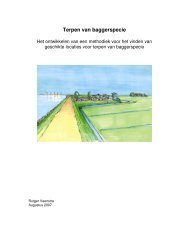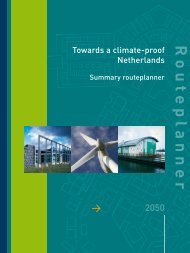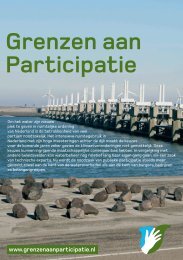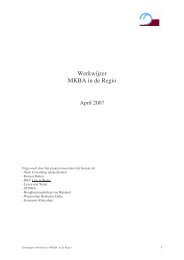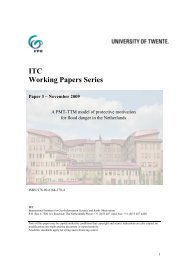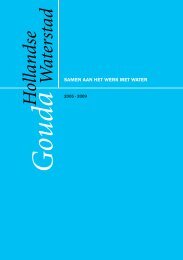Deltas on the move; Making deltas cope with the effects of climate c
Deltas on the move; Making deltas cope with the effects of climate c
Deltas on the move; Making deltas cope with the effects of climate c
- No tags were found...
You also want an ePaper? Increase the reach of your titles
YUMPU automatically turns print PDFs into web optimized ePapers that Google loves.
KvR report 001/20067.3 Adaptati<strong>on</strong>Adaptati<strong>on</strong> measures can be implemented in <strong>deltas</strong> where it would not be effective totake physical measures regarding sediment and water management. This may be<strong>the</strong> case in <strong>deltas</strong> where:- physical measures are simply not possible, for example because <strong>the</strong>re is nophysical space or sediment available;- <strong>the</strong> costs <strong>of</strong> physical measures are out <strong>of</strong> proporti<strong>on</strong> <strong>with</strong> <strong>the</strong> damage and/orlosses that would be suffered as a result <strong>of</strong> flooding.In <strong>the</strong>se <strong>deltas</strong>, measures tackling or compensating for <strong>the</strong> c<strong>on</strong>sequences <strong>of</strong> floodingare much more effective than physical measures that aim to prevent that flooding.Some indicators for <strong>deltas</strong> where this is <strong>the</strong> case include (see 6.4):- <strong>the</strong> size <strong>of</strong> <strong>the</strong> coastal plain and <strong>the</strong> amount <strong>of</strong> space available: wider delta plains<strong>of</strong>fer more opti<strong>on</strong>s for adaptati<strong>on</strong> measures such as <strong>the</strong> relocati<strong>on</strong> <strong>of</strong> people andindustries, <strong>the</strong> restricti<strong>on</strong> or directing <strong>of</strong> land use types etc;- GDP: in places <strong>with</strong> a low GDP, it will be cheaper to pay out compensati<strong>on</strong> forlosses than to take physical measures. This can be determined by means <strong>of</strong> acost-benefit analysis.The Ganges-Brahmaputra deltaThe Ganges and Brahmaputra rivers form <strong>on</strong>e <strong>of</strong> <strong>the</strong> largest river systems <strong>on</strong> Earth.The delta is also <strong>on</strong>e <strong>of</strong> <strong>the</strong> largest in <strong>the</strong> world, covering some 105.640 km 2 (seephoto). The main area <strong>of</strong> aband<strong>on</strong>ed deltaic plain lies to <strong>the</strong> west and is home to <strong>on</strong>e<strong>of</strong> <strong>the</strong> largest mangrove regi<strong>on</strong>s in <strong>the</strong> world, <strong>the</strong> Sundarbans. The site <strong>of</strong> activedeltaic sedimentati<strong>on</strong> lies to <strong>the</strong> east. Wave energy in <strong>the</strong> delta is relatively low and,as a result, few beaches are present al<strong>on</strong>g <strong>the</strong> shoreline and muddy tidal flats arecomm<strong>on</strong>. The coastline is extremely irregular as a result <strong>of</strong> <strong>the</strong> large number <strong>of</strong> tidalchannels that dissect <strong>the</strong> coast. Broad mud and silt flats border <strong>the</strong> coast. The<strong>of</strong>fshore slope in fr<strong>on</strong>t <strong>of</strong> <strong>the</strong> delta is extremely low. The Ganges-Brahmaputra deltais subsiding by more than 1.5 mm per year.Lower Deltaic plain <strong>of</strong> <strong>the</strong> Ganges-Brahmaputra delta (Hart & Coleman,2004).<str<strong>on</strong>g>Deltas</str<strong>on</strong>g> <strong>on</strong> <strong>the</strong> <strong>move</strong>The Ganges-Brahmaputra delta is <strong>on</strong>e <strong>of</strong> <strong>the</strong> world’s most densely populated <strong>deltas</strong>.Humans <strong>the</strong>refore have a major impact <strong>on</strong> <strong>the</strong> delta. The inland part <strong>of</strong> <strong>the</strong> tidal plainis now protected by dikes, and <strong>the</strong> former saline lands have been c<strong>on</strong>verted intovarious agricultural and marine farming areas. Originally, <strong>the</strong> entire surface <strong>of</strong> <strong>the</strong>aband<strong>on</strong>ed delta formed a vast expanse <strong>of</strong> mangrove forests, but large areas <strong>of</strong> <strong>the</strong>original wetlands have been c<strong>on</strong>verted for agricultural use. The <strong>on</strong>ly areas in whichagricultural expansi<strong>on</strong> has not taken place are those areas where saline tidal watersintrude into <strong>the</strong> delta plain, such as <strong>the</strong> Sundarbans. Yet even here, agricultural landis being expanded by means <strong>of</strong> <strong>the</strong> c<strong>on</strong>structi<strong>on</strong> <strong>of</strong> levees to prevent salt waterintrusi<strong>on</strong>.Fishermen at <strong>the</strong> Sundarbans (Left: www.zipc<strong>on</strong>.net/~beckyd/grapefruit -archives/fisherman_sunderbands.htm, right: www.grandpoohbah.net)Due to <strong>the</strong> high populati<strong>on</strong> density in <strong>the</strong> coastal area, <strong>the</strong> situati<strong>on</strong> in a subsidencez<strong>on</strong>e and <strong>the</strong> expected significant rise in <strong>the</strong> sea level, <strong>the</strong> number <strong>of</strong> peoplepotentially at risk <strong>of</strong> flooding as a result <strong>of</strong> <strong>climate</strong> change is high. There is <strong>the</strong>reforea great necessity to take measures.Physical measures in <strong>the</strong> Ganges-Brahmaputra delta in terms <strong>of</strong> sediment and watermanagement would appear to be virtually impossible now, despite <strong>the</strong> enormoussupply <strong>of</strong> sediment. Due to <strong>the</strong> high populati<strong>on</strong> density, <strong>the</strong>re is hardly any space leftfor any interventi<strong>on</strong> measures. Even an adaptati<strong>on</strong> measure such as <strong>the</strong> relocati<strong>on</strong> <strong>of</strong>people from <strong>the</strong> most vulnerable areas <strong>of</strong> <strong>the</strong> delta would be difficult as <strong>the</strong>re is solittle suitable and available land bey<strong>on</strong>d <strong>the</strong> delta plain.Due to <strong>the</strong> low GDP, it would <strong>the</strong>refore probably be more cost-effective to takeadaptati<strong>on</strong> measures, which could c<strong>on</strong>sist <strong>of</strong>:- <strong>the</strong> c<strong>on</strong>structi<strong>on</strong> <strong>of</strong> hills and refuge mounds to limit <strong>the</strong> c<strong>on</strong>sequences <strong>of</strong> floods;- <strong>of</strong>fering financial compensati<strong>on</strong> for losses resulting from flooding;- setting up an early warning system to warn <strong>the</strong> inhabitants in case <strong>of</strong> disasters.7677



